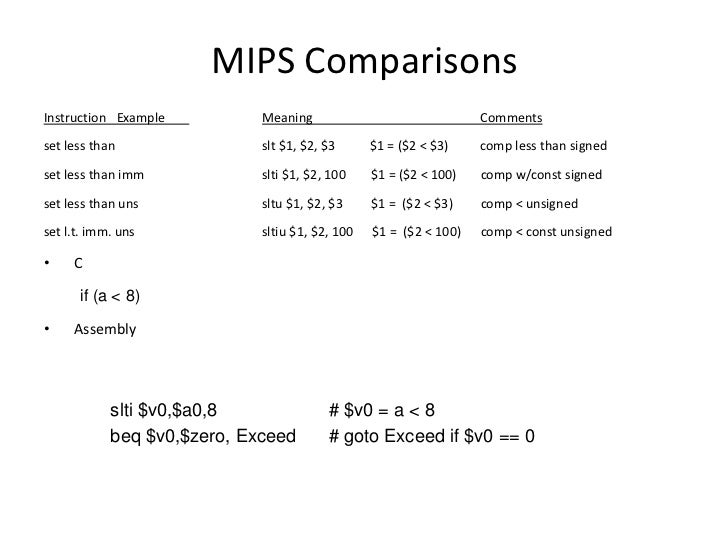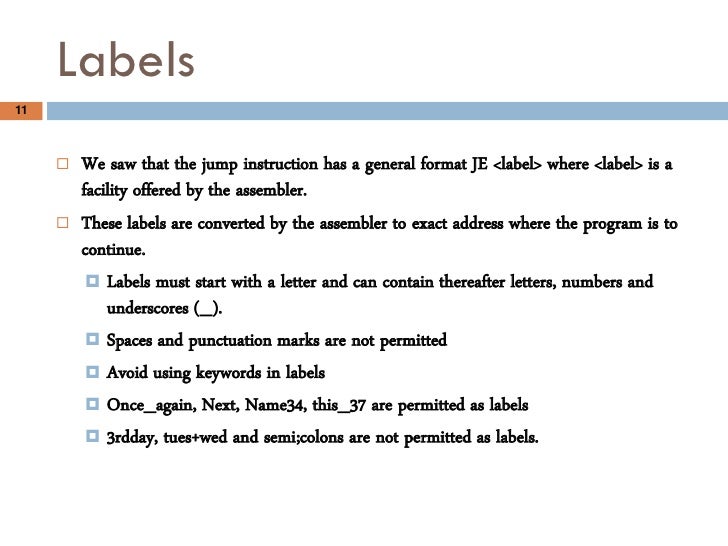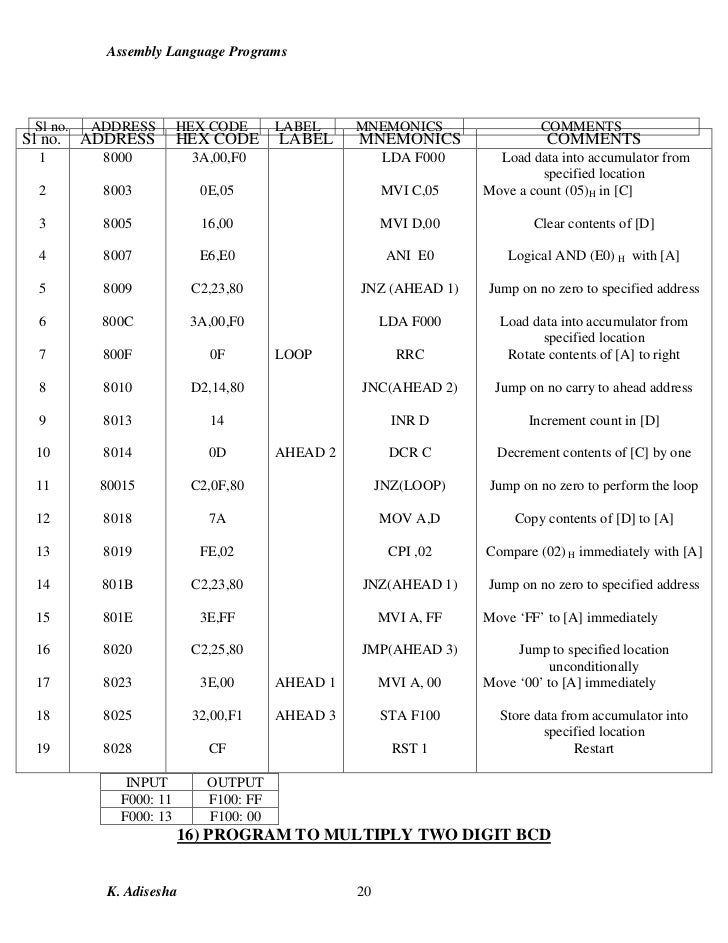39 labels in assembly language examples
Example of Assembly - University of Aberdeen The directive EQU stands for "equals"; it allows you to give a numerical value to a label. In this example, the assembler would always replace START with 1016. Hence you could write : START EQU 10 ORG START GOTO 10 The assembler would translate START as 10, and load the code at $10, as before. PDF Assembly Language Programming - UTEP - Labels are symbols - Labels must begin in column 1. - A label can optionally be followed by a colon - The value of a label is the current value of the Location Counter (address within program) - A label on a line by itself is a valid statement - Labels used locally within a file must be unique. Adapted from notes from BYU ECE124 5
PDF George M. Georgiou Brian Strader - Georgetown University The above listing is a typical hello world program written in LC-3 assembly language. The program outputs "Hello World!" to the console and quits. We will now look at the composition of this program. Lines 1 and 2 of the program are comments. LC-3 uses the semi-colon to denote the beginning

Labels in assembly language examples
Assembly Language Syntax by Valvano Examples. Assembly Language Syntax Programs written in assembly language consist of a sequence of source statements. Each source statement consists of a sequence of ASCII characters ending with a carriage return. Each source statement may include up to four fields: a label, an operation (instruction mnemonic or assembler directive), an operand ... LC3 Assembly Language.ipynb - Bryn Mawr College The assembler first goes through the source code collecting labels, and their locations. During the second pass, it can substitute the used label in the operands with the label location minus instruction location - 1. .ORIG x4000 x4000 LD R1, SIX x4001 HALT x4002 SIX: .FILL #23 .END. So, the PC-offset for SIX is x4002 - x4000 - 1 = 1. Assembly Language Programming • ECEn 323: Computer Organization Assembly language is more readable than the binary machine code and is easier to edit and manipulate. The purpose of the "assembler" is to translate the text assembly language file written by a human into binary machine code executed by the processor (See section 2.12 in the textbook). This process is tedious and best left to a computer.
Labels in assembly language examples. pic microcontroller assembly language programming examples For example MOVLW is an Opcode. Labels. A label is an identifier used to represent a line in code or section of a program. Goto statements can be used in conjunction with a Label to jump to the execution of code identified by the particular label. See Task 1 code for example. ... pic microcontroller assembly language examples 6. Jumping to Labels in Inline Assembly | Microsoft Docs Labels defined in __asm blocks are not case sensitive; both goto statements and assembly instructions can refer to those labels without regard to case. C and C++ labels are case sensitive only when used by goto statements. Assembly instructions can jump to a C or C++ label without regard to case. The following code shows all the permutations: C++ Assembly Language Format Assembly language source files are ordinary text files that are saved with a "jas" file extension. You can write your programs in any text editor or use the simulator's integrated editor/assembler. ... Examples: goto label ifeq label iflt label if_icmpeq label: goto top ifeq top iflt top if_icmpeq top: The label operand is a program label in ... PDF Lecture 5 Basic Elements of Assembly Language Data Labels : a data label identifies the location of a variable, providing a convenient way to reference the variable in code. The following, for example, defines a variable named count: count DWORD 100 The assembler assigns a numeric address to each label. It is possible to define multiple data items following a label.
PDF Assembly Language: Overview - Princeton University Jump and Labels: While Loop! while (n>1) { } Checking if EDX is less than or equal to 1. 28 movl %edx, %eax andl $1, %eax je else jmp endif else: endif: ... • Read more assembly-language examples! • Chapter 3 of Bryant and OʼHallaron book! • Generate your own assembly-language code! • gcc217 -S -O2 code.c! 8051 - "Label" in Assembly language - Stack Overflow "Label" in Assembly language Ask Question 1 I have couple of examples which are pretty simple except LABEL concept. Example 1 adds 25 10 times in itself, whereas example 2 takes complement of Register A 700 times. How do labels execute in Assembly? - Stack Overflow This can be more useful for strings where you might want to address the suffix of one string separately. e.g. instead of a separate .asciz "\n" you might just stick a label on the newline at the end of another string. Related Q&As: examples of fall-through of labels What if there is no return statement in a CALLed block of code in assembly programs Assembly - Label | Assembly | Datacadamia - Data and Co Grammar - Label in Assembly. A label is a name given to an addresses. Without the programmer would be required to manually calculate them. It's used to identify a target address storing: a instruction for a branch instruction (ie the value of the target address is executed) data (ie the value of target address is used as data in an operation)
SECTION V-10: Rules for Labels in Assembly Language The names used for labels in assembly language programming consist of alphabetic letters in both upper and lower case, the digits 0 through 9, and the special characters question mark (?), period (.), at (@), underline (_), and a dollar sign ($). The first character of the label must be an alphabetic character. Labels and Mainframe Assembler Macro Usage Macro with Branch & Labels The following examples will show how to use Macro Files that will generate code with Branch Instructions and unique labels. Branch with a Specified Label Using explicit names in the mainline code creates code that is simple and easy to understand. Assembly - Addressing Modes - Tutorials Point Assembly - Addressing Modes. Most assembly language instructions require operands to be processed. An operand address provides the location, where the data to be processed is stored. Some instructions do not require an operand, whereas some other instructions may require one, two, or three operands. When an instruction requires two operands ... Embedded Systems - Assembly Language - Tutorials Point The names used for labels in assembly language programming consist of alphabetic letters in both uppercase and lowercase, number 0 through 9, and special characters such as question mark (?), period (.), at the rate @, underscore (_), and dollar ($). The first character should be in alphabetical character; it cannot be a number.
PDF Chapter 3 Assembly Language Fundamentals Assembly language instructions can have between zero and three operands, each of which can be a register, memory operand, constant expression, or I/O port. ... • constant expression: ex. 10 * 10 • register: ex. eax • memory (data label): ex. count Examples of assembly language instructions having varying numbers of operands • No ...
Local Labels - Elements of Assembly Language Here are some examples of legal identifiers: Grab Hold Widget Pot_of_Message MAXNAME A numeric label consists of a digit (0 to 9) followed by a colon. As in the case of alphanumeric labels, a numeric label assigns the current value of the location counter to the symbol.
2 Assembly Language Programming - University of New Mexico In an assembly language program, a label is simply a name for an address. For example, given the declarations shown in Example 2.1, ``x'' is a name for the address of a memory location that was initialized to 23. On the SPARC an address is a 32-bit value. As such, labels are 32-bit values when they are used in assembly language programs.
Labels (x86 Assembly Language Reference Manual) - Oracle When a numeric label is used as a reference (as an instruction operand, for example), the suffixes b ("backward") or f ("forward") should be added to the numeric label. For numeric label N, the reference Nb refers to the nearest label N defined before the reference, and the reference Nf refers to the nearest label N defined after the reference.
Learning Assembly Language | Codementor Typically examples are telling the assembler that the following instructions are code (usually via a .text directive) vs. data (usually via a .data directive). Like regular instructions, these instructions are typically written on their own line, however, the inform the assembler rather than generate machine code instructions directly.
Assembly Language | 101 Computing Assembly languages also let you use labels in the code to point to specific memory locations or registers. LMC LMC (Little Man Computer) is an example of basic assembly language used for educational purposes. It consists of only 11 mnemonics (e.g. INP, OUT, STA, BRP, etc.) and is based on one memory addressing mode: direct addressing. ...
Assembly language - Wikipedia Example: in the following code snippet, a one-pass assembler would be able to determine the address of the backward reference BKWD when assembling statement S2, but would not be able to determine the address of the forward reference FWD when assembling the branch statement S1; indeed, FWD may be undefined.
Label (computer science) - Wikipedia In assembly language labels can be used anywhere an address can (for example, as the operand of a JMP or MOV instruction). Also in Pascal and its derived variations. Some languages, such as Fortran and BASIC, support numeric labels. Labels are also used to identify an entry point into a compiled sequence of statements (e.g., during debugging ).
PDF Assembly Language - University of Texas at Austin NOW, Under21, R2D2, and C3PO are all examples of possible LC-3bassembly language labels. There are two reasons for explicitly referring to a memory location. 1. The location contains the target of a branch instruction (for example, AGAIN in line 0E). 2.
Assembly Language Programming • ECEn 323: Computer Organization Assembly language is more readable than the binary machine code and is easier to edit and manipulate. The purpose of the "assembler" is to translate the text assembly language file written by a human into binary machine code executed by the processor (See section 2.12 in the textbook). This process is tedious and best left to a computer.
LC3 Assembly Language.ipynb - Bryn Mawr College The assembler first goes through the source code collecting labels, and their locations. During the second pass, it can substitute the used label in the operands with the label location minus instruction location - 1. .ORIG x4000 x4000 LD R1, SIX x4001 HALT x4002 SIX: .FILL #23 .END. So, the PC-offset for SIX is x4002 - x4000 - 1 = 1.
Assembly Language Syntax by Valvano Examples. Assembly Language Syntax Programs written in assembly language consist of a sequence of source statements. Each source statement consists of a sequence of ASCII characters ending with a carriage return. Each source statement may include up to four fields: a label, an operation (instruction mnemonic or assembler directive), an operand ...














Post a Comment for "39 labels in assembly language examples"